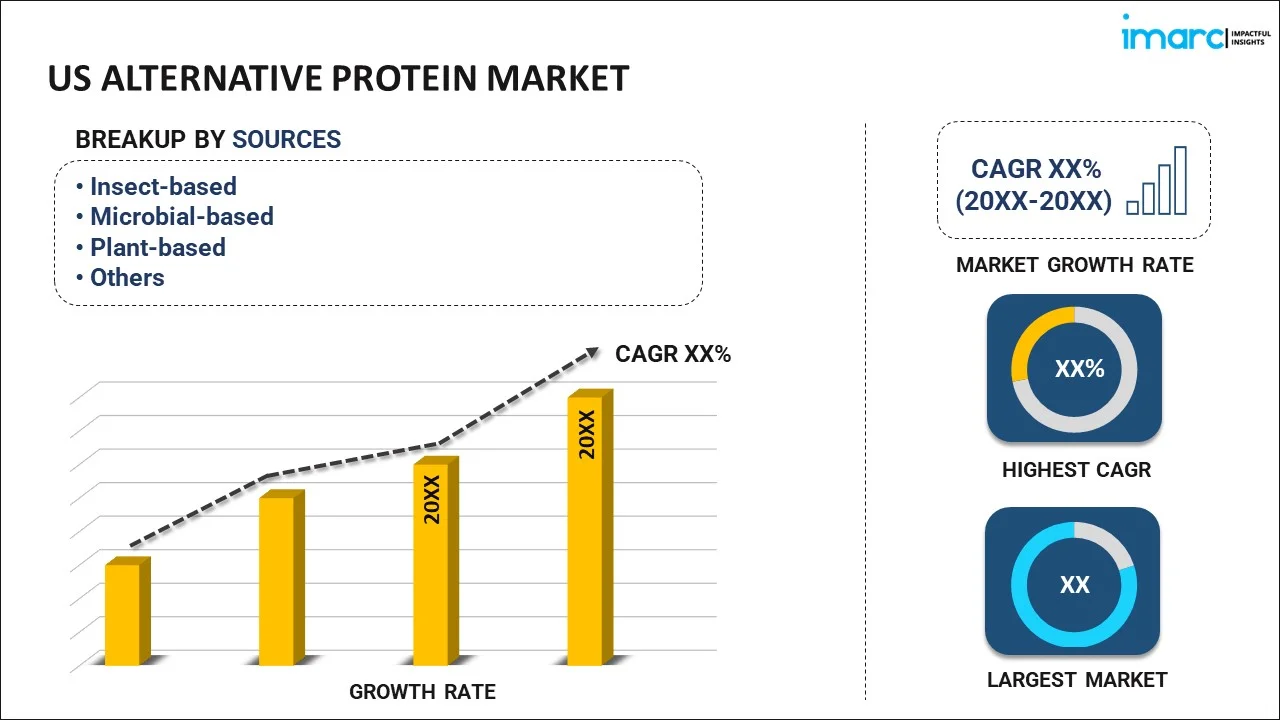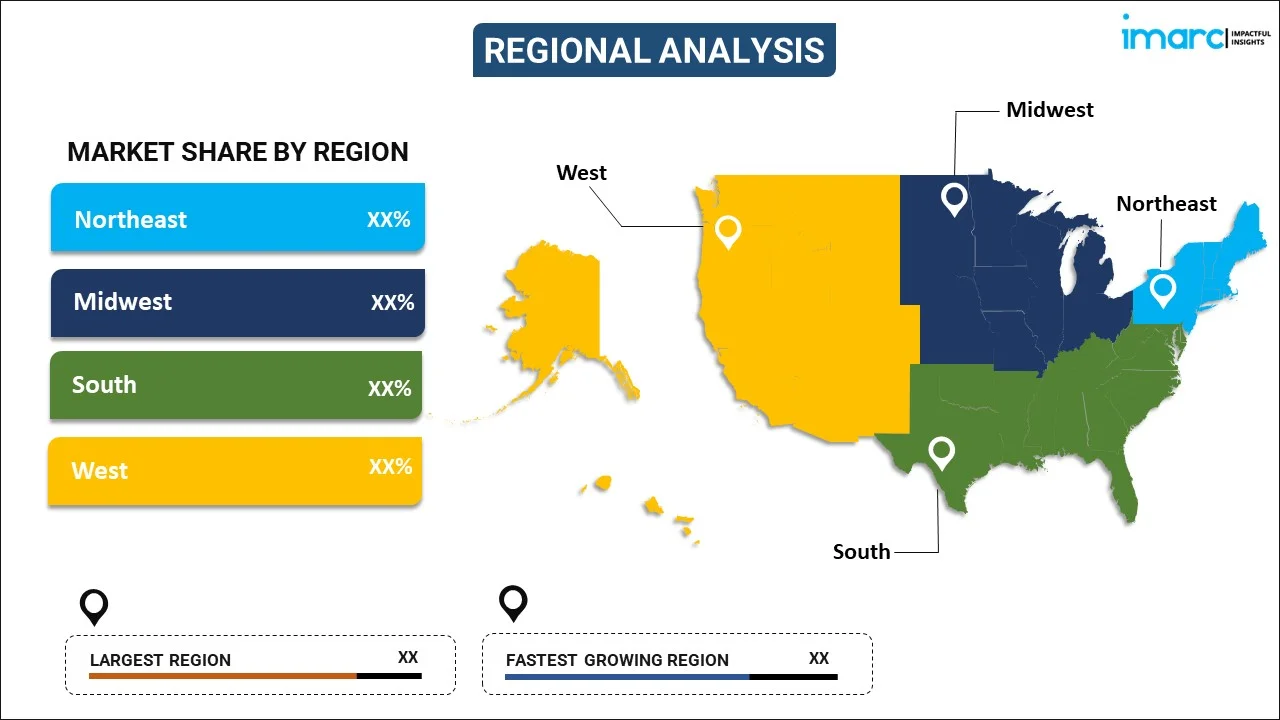
US Alternative Protein Market Report by Source (Insect-based, Microbial-based, Plant-based, and Others), Application (Food and Beverage, Dietary Supplements, Animal Feed and Pet Food, Personal Care and Cosmetics), and Region 2025-2033
US Alternative Protein Market Overview:
The US alternative protein market size reached USD 6.1 Billion in 2024. Looking forward, IMARC Group expects the market to reach USD 20.6 Billion by 2033, exhibiting a growth rate (CAGR) of 14.5% during 2025-2033. The rising awareness on environmental responsibility and health consciousness, an enhanced focus on the creation of diverse product offerings catering to various preferences, and the rising concerns regarding animal welfare represent some of the key factors driving the market.
|
Report Attribute
|
Key Statistics
|
|---|---|
|
Base Year
|
2024 |
|
Forecast Years
|
2025-2033
|
|
Historical Years
|
2019-2024
|
| Market Size in 2024 | USD 6.1 Billion |
| Market Forecast in 2033 | USD 20.6 Billion |
| Market Growth Rate (2025-2033) | 14.5% |
Alternative proteins refer to sustainable and ethical protein sources that are an alternative to conventional animal-based proteins. They encompass various sources of protein that include plant-based proteins, cultured or lab-grown proteins, and proteins extracted from insects or algae, and not derived from traditional livestock or poultry. Plant-based proteins are derived from plants such as peas, soy, lentils, and chickpeas, often used in meat substitutes for their similarity to traditional animal-based products, and they are a sustainable option, consuming fewer natural resources and emitting fewer greenhouse gases. On the other hand, cultured or lab-grown proteins are produced through cellular agriculture by cultivating animal cells in a controlled environment, resulting in a product that is genetically identical to conventional meat, eliminating the need for animal slaughter. Their diversity offers a wide range of flavors and textures, they are rich in essential amino acids, vitamins, and minerals, and their accessibility provides options for individuals with dietary restrictions or preferences and aligning with ethical considerations such as animal welfare.
US Alternative Protein Market Trends:
The market in the US is primarily driven by the increasing consumer interest in sustainable food practices, which emphasizes environmental responsibility and health consciousness. In line with this, the rising prevalence of dietary restrictions and choices such as veganism and vegetarianism is also providing an impetus to the market. Moreover, the rising concerns regarding animal welfare, along with the growing awareness of the environmental impact of traditional animal agriculture, are acting as significant growth-inducing factors. In addition to this, the innovation in product development, resulting in more diverse product offerings, is attracting a broader consumer base. The market is further driven by the increase in government support for sustainable agriculture and food practices, and the collaborations between food producers and researchers. Besides this, the investments in research and technological advancements leading to scalable and efficient production are creating lucrative opportunities in the market. The market is also experiencing growth due to the increased educational campaigns promoting the nutritional benefits of alternative proteins, and the alignment of alternative protein products with global health trends. Apart from this, the broadening distribution channels both online and offline, coupled with the urbanization trends embracing alternative diets, are propelling the market. Some of the other factors contributing to the market include changing consumer perceptions towards health and nutrition, the cultural shift towards food diversity and inclusivity, the demand for localized and responsibly sourced products, and the emergence of specialized retailers focusing exclusively on alternative protein products.
US Alternative Protein Market Segmentation:
IMARC Group provides an analysis of the key trends in each segment of the US alternative protein market report, along with forecasts at the country level for 2025-2033. Our report has categorized the market based on source and application.
Source Insights:

- Insect-based
- Microbial-based
- Plant-based
- Others
The report has provided a detailed breakup and analysis of the market based on the source. This includes insect-based, microbial-based, plant-based, and others.
Application Insights:
- Food and Beverage
- Dietary Supplements
- Animal Feed and Pet Food
- Personal Care and Cosmetics
A detailed breakup and analysis of the market based on the application has also been provided in the report. This includes food and beverage, dietary supplements, animal feed and pet food, personal care and cosmetics.
Regional Insights:

- Northeast
- Midwest
- South
- West
The report has also provided a comprehensive analysis of all the major regional markets, which include Northeast, Midwest, South, and West.
Competitive Landscape:
The report has also provided a comprehensive analysis of the competitive landscape in the market. Competitive analysis such as market structure, key player positioning, top winning strategies, competitive dashboard, and company evaluation quadrant has been covered in the report. Also, detailed profiles of all major companies have been provided.
US Alternative Protein Market Report Coverage:
| Report Features | Details |
|---|---|
| Base Year of the Analysis | 2024 |
| Historical Period | 2019-2024 |
| Forecast Period | 2025-2033 |
| Units | Billion USD |
| Scope of the Report | Exploration of Historical and Forecast Trends, Industry Catalysts and Challenges, Segment-Wise Historical and Predictive Market Assessment:
|
| Sources Covered | Insect-based, Microbial-based, Plant-based, Others |
| Applications Covered | Food and Beverage, Dietary Supplements, Animal Feed and Pet Food, Personal Care and Cosmetics |
| Regions Covered | Northeast, Midwest, South, West |
| Customization Scope | 10% Free Customization |
| Post-Sale Analyst Support | 10-12 Weeks |
| Delivery Format | PDF and Excel through Email (We can also provide the editable version of the report in PPT/Word format on special request) |
Key Questions Answered in This Report:
- How has the US alternative protein market performed so far and how will it perform in the coming years?
- What has been the impact of COVID-19 on the US alternative protein market?
- What is the breakup of the US alternative protein market on the basis of source?
- What is the breakup of the US alternative protein market on the basis of application?
- What are the various stages in the value chain of the US alternative protein market?
- What are the key driving factors and challenges in the US alternative protein market?
- What is the structure of the US alternative protein market and who are the key players?
- What is the degree of competition in the US alternative protein market?
Key Benefits for Stakeholders:
- IMARC’s report offers a comprehensive quantitative analysis of various market segments, historical and current market trends, market forecasts, and dynamics of the US alternative protein market from 2019-2033.
- The research study provides the latest information on the market drivers, challenges, and opportunities in the US alternative protein market.
- Porter's five forces analysis assist stakeholders in assessing the impact of new entrants, competitive rivalry, supplier power, buyer power, and the threat of substitution. It helps stakeholders to analyze the level of competition within the US alternative protein industry and its attractiveness.
- Competitive landscape allows stakeholders to understand their competitive environment and provides an insight into the current positions of key players in the market.
Need more help?
- Speak to our experienced analysts for insights on the current market scenarios.
- Include additional segments and countries to customize the report as per your requirement.
- Gain an unparalleled competitive advantage in your domain by understanding how to utilize the report and positively impacting your operations and revenue.
- For further assistance, please connect with our analysts.
 Request Customization
Request Customization
 Speak to an Analyst
Speak to an Analyst
 Request Brochure
Request Brochure
 Inquire Before Buying
Inquire Before Buying




.webp)




.webp)












